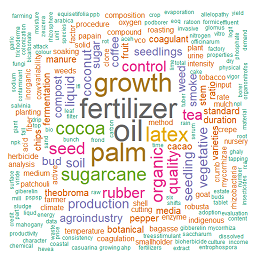Teknologi Pembuatan Lateks Dadih Melalui Proses Penggetaran
DOI:
https://doi.org/10.25181/jaip.v7i1.906Keywords:
latex, concentrated latex, vibration, cmcAbstract
Obstacles factor to get natural rubber raw materials is less efficient for latex processing into concentrated latex, because it need a long time that 2-3 weeks. Centrifugation method many used by concentrated latex factory because it can concentrate the latex with a short relatively time. While the weakness of the centrifugation method is more expensive if that compared with the curdling. With the weakness centrifugation method and curdling, in this research, making the concentrated latex are used vibration method, with the addition of curdle. The purpose of this research is to get the optimum vibrations speed for the concentrated latex manufactured, the speed of the vibrations are used 150 rpm, 175 rpm, 200 rpm, 225 rpm and 250 rpm. The design are used in this research is Randomized Block Design with 6 treatments was repeated 4 times, then obtained 24 units of the experiment, if there is a real difference, then used the BNT at the level of 5% and the data analysis process using Minitab version 16. the most optimum RPM are used in this research is 225 with a quality approaching the standard.Downloads
References
Ali, F., Sihombing, A., & Fauzi, A. (2010). Koagulasi lateks dengan ekstrak gadung (Dioscorea hispida Dennts). Jurnal Teknik Kimia, 17(3), 8-16.
Dalimunthe, V. H. Penentuan Kandungan Padatan Total (% TSC) Lateks Pekat dan Pengaruhnya Terhadap Kekuatan Tarik Benang Karet di PT. IKN–Medan.
Darmawan, N., Fitrianti, F., & Dewi, I. R. (2017, November). Lateks karet alam bebas protein menggunakan natrium hidroksida. In Prosiding Seminar Nasional Kulit, Karet dan Plastik (Vol. 6, No. 1).
Juniarti, D. (2008). Teknologi Proses Pencangkokan Akrilat Pada Karet Alam Menggunakan Inisiator Hidrogen Peroksida. Skripsi. Institut Pertanian Bogor. Bogor.
Krisnawati. (2014). Kopolimerisasi Cangkok Stirena dan Metil Metakrilat pada Lateks Karet Alam Berpotensi Rendah. Skripsi. Institut Pertanian Bogor. Bogor.
Kurniasih, N. (2002). Efisiensi Pemekatan Lateks Dengan Metode Sentifugasi. Skripsi. Institut Pertanian Bogor. Bogor.
Maspanger, D. R. (2007). Pembuatan lateks dadih dengan proses sentrifugasi putaran rendah dan kualitas barang jadi karetnya. Agritech, 27(3), 124-129.
Nurhayati, C., & Andayani, O. (2015). Pengolahan lateks pekat proses dadih menggunakan garam alginat hasil ekstraksi rumput laut untuk produk busa. Jurnal Dinamika Penelitian Industri, 26(1), 49-58.
Prastanto, H., Falaah, A. F., & Maspanger, D. R. (2014). Pemekatan lateks kebun secara cepat dengan proses sentrifugasi putaran rendah. Jurnal Penelitian Karet, 32(2), 181-188.
Purbaya, M., & Suwardin, D. (2017). Pengujian kualitatif terhadap jenis koagulan dalam bahan olah karet. Indonesian Journal of Natural Rubber Research, 35(1), 103-114.
Santi, F., Restuhadi, F., & Ibrahim, A. (2017). Potensi Ekstrak Kasar Enzim Bromelin pada Bonggol Nanas (Ananas comosus) Sebagai Koagulan Alami Lateks (Hevea brasiliensis). Jurnal Online Mahasiswa Fakultas Pertanian Universitas Riau, 4(1), 1-13.
Susanto, T., & Nurhayati, C. (2017). Pengaruh temperatur dan waktu depolimerisasi lateks dadih terhadap penurunan berat molekul dan mutu lem karet. Jurnal Dinamika Penelitian Industri, 28(1), 32-41.
Downloads
Published
How to Cite
Issue
Section
License
Authors who publish with Jurnal Agro Industri Perkebunan agree to the following terms:
Authors retain copyright and grant the Jurnal Agro Industri Perkebunan right of first publication with the work simultaneously licensed under a Creative Commons Attribution License (CC BY-SA 4.0) that allows others to share (copy and redistribute the material in any medium or format) and adapt (remix, transform, and build upon the material for any purpose, even commercially) with an acknowledgment of the work's authorship and initial publication in Jurnal Agro Industri Perkebunan.
Authors are able to enter into separate, additional contractual arrangements for the non-exclusive distribution of the journal's published version of the work (e.g., post it to an institutional repository or publish it in a book), with an acknowledgment of its initial publication in Jurnal Agro Industri Perkebunan. Authors are permitted and encouraged to post their work online (e.g., in institutional repositories or on their website) prior to and during the submission process, as it can lead to productive exchanges, as well as earlier and greater citation of published work.


























